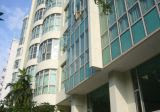Dr Michael Lim Mah Hui, senior fellow of Socio-economic and Environmental Research Institute (Seri), a think tank, said the investors comprise wealthy Malaysians and foreigners.
The price rise is making property increasingly out of reach for the average Penangites. The strong demand means that developers were putting more expensive price tags on their projects.
Lim, a banker who worked with Credit Suisse, Standard Chartered Bank and the Asian Development Bank, said from 1999 to 2008, the prices of property in Penang rose 40 per cent.
This increase is a tenth more than that for the whole country, and it is still going up.
"Condominiums cost RM250 per square feet in 2008 but now the price is RM350 to RM500, depending on the location," Lim said during Seri's roundtable on housing affordability gap in George Town last week.
However, it is not surprising if entire development projects are sold out in two days now as buyers are easily taken in by attractive down payments as low as 1 per cent and the low interest rates for housing loans, he said.
The public may not fully understand the risks of adjustable-rate mortgage (ARM) when they sign up for loans, for example. An ARM gives low rates at the start of a loan but the rates go up after the promotional period.
"Such a situation can result in a (real estate) bubble, which nobody can tell when it will happen," Lim said.
He said certain developers were not helping the situation by reserving the best units for their "special customers".
"Some developers let their prime customers and insiders cherry pick the units they want first before everyone else.
"When the average house buyers visit the developers' sales galleries at the project launch, they find many units had already been sold, encouraging many of them to quickly make down payments for the remaining units as well," he said.
Lim expressed concern that there is a mismatch of supply and demand for properties in the state with many houses, flats and apartments vacant.
He said in 2000, there were 355,436 housing units in Penang but only 284,969 households, indicating an oversupply of 20 per cent.
"Since then, more units have been built. If you go round at night, you will notice that many homes are unoccupied, especially super-condominiums that are beyond the affordability of average households.
"This is also an indication that there is an undersupply of affordable housing in the state," Lim said.
He proposed that the state government study how Singapore's Housing and Development Board managed its public housing. Penang Development Corp should also undertake more land reclamation to develop more affordable homes.



No comments:
Post a Comment